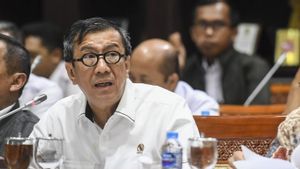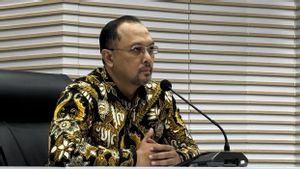JAKARTA - Generally, the success of a country's economic performance can be seen from three main things, namely output or gross domestic product (GDP), the unemployment rate, and inflation.
The three macro variables are interrelated. If the real output produced by a country exceeds the potential output then this is commonly referred to as economic growth. The indicator is the creation of inflation. Inflation itself must be maintained at a certain level so that productive activities can continue to run in a balanced situation.
If the economic process runs in a good growth range, the availability of job opportunities will also increase. This will have an impact on the absorption of the workforce. The opposite is true if growth is stagnating, let alone decreasing, it is almost certain that the number of unemployed will increase.
Quoting the economic variables that were triggered by Arthur Melvin Okun, it can be concluded that economic growth has a correlation with the unemployment rate. This variable, which is often referred to as Okun's law, cannot be applied equally to all countries because each region has its own characteristics. Nevertheless, Okun's law can be used as a guide in analyzing macroeconomics which is useful for establishing a policy.
Okun's law, as explained by Samuelson (2005), states that for every 2 percent decline in GDP it is estimated that the unemployment rate will increase by 1 percent.
Take the case of Indonesia. Last week, the Central Statistics Agency (BPS) said that economic growth throughout 2020 contracted to minus 2.07 percent. In fact, the country's average growth in the past five years is at the 5 percent level.
This means that if you apply the Law of Okum to the Indonesian context, there will be a decrease in GDP of 7 percent in just one year. This means that there has been a new increase in unemployment as much as 3.5 percent of the entire workforce in Indonesia over the past year.
This fact was confirmed by the release of BPS on November 10, 2020. It was stated that as of August 2020 the number of unemployed people in Indonesia had increased to 9.77 million people or the equivalent of 7.07 percent from the previous 7.1 million people or 5.23 percent as of August 2019. The estimated total workforce in that period was 138.22 million people.
For information, this unemployment indicator is very important in determining future macroeconomic policies. This is because the government needs a percentage and employment data to become a reference in creating employment opportunities.
This also makes the President always announce the unemployment rate in Indonesia in a plenary session with the DPR every August 16 as an indicator of the success of the government's performance in economic development.
SolutionSeparately, the Executive Director of the Institute for Development of Economics and Finance (Indef) Enny Sri Hartati said that the government needed to increase efforts to create jobs in order to keep household consumption levels from falling further.
The reason is, in the economic cycle, employment means giving people the ability to remain consumptive through the income they receive. If this scenario occurs, demand will grow, which will lead to an increase in output in shaping GDP.
“The most likely sector is labor-intensive, because usually the lower class people who enter this sector dominate in Indonesia. This group, if they get the money, must be used to buy basic daily needs. So the economy can continue to rotate and consumption will not decline, ”he told VOI, Friday, February 5.
Enny added that he had predicted that the contraction in economic growth throughout 2020 was caused by the drop in household consumption levels.
This analysis is again agreed by BPS, which states that consumption has collapsed to a level of minus 2.63 percent, which is a reflection of the low purchasing power of the people.
"Consumption goes down, let alone down to minus, it is certain that investment will also decline. This is because 80 percent of the products produced by investment are absorbed by the domestic market. So the strategic effort that the government can do is to keep consumption stable, "he said. The Indef economist also criticized the government's strategy which tends to focus on dealing with the domestic financial sector rather than maintaining household consumption levels.
"It is true that financial policies such as credit restructuring in banks and finance companies can maintain consumption, but it takes time for the transmission process in the field to reach the public," he said.
For information, reporting Indonesia's 2020 GDP at the current price of IDR 15,434.2 trillion or IDR 56.9 million per capita.
If you look at the growth in terms of expenditure, household consumption and investment contributed 89.4 percent of last year's GDP formation.
The English, Chinese, Japanese, Arabic, and French versions are automatically generated by the AI. So there may still be inaccuracies in translating, please always see Indonesian as our main language. (system supported by DigitalSiber.id)













